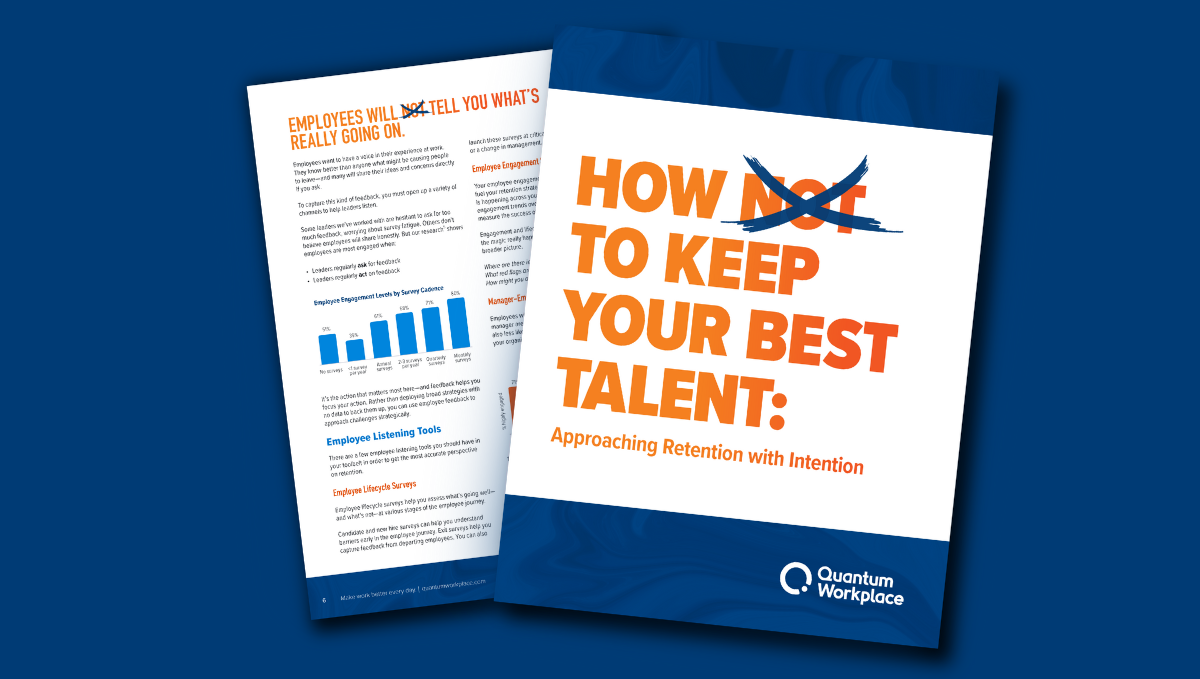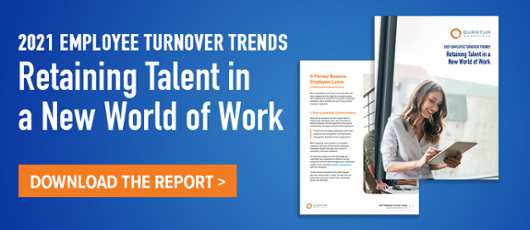Why Employee Retention is Important
It’s no secret that retaining top talent is key to promoting organizational growth. Recruiting and retaining new employees is expensive and time consuming. Moreover, turnover negatively affects the productivity and morale of your employees.
Due to worker shortages in the past year, leaders have scrambled to combat turnover. The need to adopt effective retention strategies has become increasingly prevalent.
In this article we will:
- Define employee retention and its importance
- Describe the benefits of a strong retention strategy
- Provide strategies to retain employees
- Discuss the role of technology in driving employee retention
What Is Employee Retention
Employee retention can be defined as an organization’s ability to keep its employees. Whether you have high or low turnover, you can prevent top talent from leaving with the right practices and strategies.
Employee turnover is usually represented in percentages that vary by industry. Turnover rates can span anywhere from 20 percent in public-sector roles to 60 percent in professional services, according to the U.S. Bureau of Labor Statistics.
A strong employee retention strategy combats voluntary employee turnover. And when you reduce voluntary turnover, you avoid unnecessary costs and roadblocks to growth.
Why Employee Retention Matters
Employee retention promotes the health and success of your organization. The time, stress, and cost of hiring and training new employees are significant, and turnover can have a negative impact on your business outcomes. High employee turnover brings about multiple problems including high costs, knowledge loss, and low productivity.
Turnover Expenses
Replacing employees is expensive, with costs ranging anywhere from 16% to 213% of an employees’ salary. U.S. organizations pay up to 1 trillion in turnover expenses annually.
Advertising your company to future candidates, interviewing, onboarding, and training take many hours. This creates a high cost for your organization.
Lost Knowledge
When seasoned employees leave, their knowledge goes with them. When employees fail to relay their institutional knowledge to their peers, their information and skills can be lost forever. This can lead to low productivity and confusion among team members left behind.
Roadblocks to Productivity
As a position remains unfilled, hours of lost productivity pile up. When other employees pick up the slack for unfilled roles, they might get burned out and overall productivity will plummet.
Additionally, it takes a long time to bring a new hire up to maximum levels of productivity. Research says it takes a new hire one to two years to achieve the productivity levels of an existing employee.
9 Benefits of Employee Retention
1. Reduced costs.
Turnover is expensive—period. Recruiting and onboarding new hires is time consuming and especially detrimental when paired with severance costs. In addition, inexperienced employees can reduce the quality of your customer experience, causing revenue loss. Save your organization time and money with a solid retention strategy.
2. Improved morale.
When valued employees leave, it’s a downer for their team members. Effective retention strategies can boost morale.
When employee morale is high, the workplace becomes a more positive place. Positivity rubs off on employees, making them believe their company is a great place to work. Happy employees are likely to stay and become great advocates for your company.
3. Increased productivity.
Productivity and engagement tend to be higher among tenured employees. Long-term employees have had time to develop their abilities, can accomplish tasks within a shorter amount of time, and are more committed to the success of the business.
Research also shows that high engagement levels lead to increased productivity and better quality of work. When you focus on engagement and retention, employees notice and perform better.
4. Increased customer experience.
Focusing on retention makes employees happy. And employees who are happy exude that feeling to customers. Employee happiness correlates with high engagement, and high engagement leads to better customer service.
Plus, employees who have been at their company long-term can solve complicated problems to boost customer satisfaction.
5. Less time spent recruiting and training.
As an HR leader you already have a lot on your plate. When your organization is in need of talent, recruitment efforts can be disruptive and time consuming. By decreasing the amount of time spent interviewing and onboarding new hires, you can spend more time investing in strategic initiatives that improve the employee experience and prevent turnover.
6. Improved company culture.
Your company culture affects whether your employees leave or stay. If you experience high retention rates, you can thank your culture initiatives. In fact, 72 percent of workers cited workplace culture as a driving factor in whether they work at a company or not.
When you’re able to engage and retain your employees, they’ll feel more connected to their work, their team, and your company culture. Ideal company cultures celebrate employees, leverage great benefits, and prioritize inclusivity. With low turnover, your norms will be naturally adopted and maintained in the every-day employee experience.
7. Higher employee engagement.
Research shows that there is a direct link between employee engagement and retention. Employees who are highly engaged are 1.8 times more likely to say they will be working at their current organization a year from now.
So, it’s no surprise that organizations who prioritize retention efforts have highly engaged employees. And organizations who have highly engaged employees reap many benefits, including:
- Better employee heath
- Happy and satisfied employees
- Lower absenteeism
- Greater employee loyalty
- Better customer service
- Higher profitability
8. Improved revenue and ROI.
Retention problems reduce the ROI of your talent strategies. Between hiring costs, training investments, and lost sales and productivity, it’s costly to lose and replace a departing employee. These costs have direct and indirect impacts on your bottom line.
9. More employee expertise.
The longer an employee stays, the longer they have to develop their expertise. They have the ability to understand organizational nuances and procedures that new hires can’t yet grasp.
Plus, the longer an employee stays, the more value they provide the company. As employees stay, their dedication to driving business outcomes grows. With time and employee development, your average performers can become rising stars.
6 Strategies to Improve Employee Retention
Considering the benefits that organizations reap from low turnover, it’s important to adopt the strategies that drive employee retention. By hiring the right talent and centering your retention strategies around them, you can better ensure your employees are with you for the long haul.
1. Hire strategically.
Investing in the right hires from the jump is a key way to ensure you aren’t throwing away your recruiting and training investment. In fact, 80% of turnover is due to bad hiring decisions. You don’t want to spend money on a new hire just for them to quit a few months later.
To avoid misalignment in skills and role responsibilities, clearly explain your expectations for the position. Be aware of possible mismatches in experience and culture during the interview process.
2. Improve the onboarding experience.
Effective onboarding is an integral part of retaining employees. In fact, 40% of employees who did not receive adequate training leave their job within a year. Onboarding is more than giving an office tour or training employees for a few days. Onboarding should be a year-long process that achieves multiple goals.
Effective onboarding reinforces a positive impression, sets clear expectations, clarifies policies and benefits, and integrates new hires into the company culture. It also connects new hires with existing team members and enables planning for their long-term future.
3. Leverage feedback from top to bottom.
Employee feedback drives growth at all levels of your organization. When feedback is used consistently, employees understand what they are doing well, and what they could improve upon. When leaders are transparent, employees are less likely to feel left in the dark and become a retention risk. Plus, their quality of work will increase as they improve over time.
Leaders should create a channel for employees to give feedback as well. This helps companies grow to support their employees and attend to their needs. Practice continuous listening, hold regular 1-on-1s, and leverage employee surveys to safeguard employee turnover.
4. Prioritize recognition.
To retain top talent, leverage recognition processes that make your employees feel valued. This is important, as nearly two-thirds of employees would leave their position if they didn’t feel appreciated by their manager.
When recognition is used consistently, employees feel competent and respected, making them unlikely to explore their options elsewhere.
5. Drive employee growth.
A great way to prevent turnover is by giving employees opportunities for growth and development. Our research shows that only 38 percent of departing employees said they saw professional growth and career development opportunities for themselves at their organizations.
To reduce retention risks, encourage long-term goal setting, provide coaching and mentorship, and leverage internal hires when possible. Prioritize consistent growth conversations and be vocal about available opportunities to your employees.
6. Uncover insights from exit surveys.
Sometimes employee turnover is inevitable. Luckily, you can gain valuable insights from employees who have decided to leave.
Leverage exit surveys to receive direct feedback from departing employees. Ask them their reasons for leaving and possible suggestions for improvement. This helps you improve the employee experience for those who remain at your company.
The Role of Technology in Employee Retention
Employee success drives business success, and it’s critical to prevent your top performers from leaving. With the right software, you can streamline and accelerate your retention initiatives.
Our employee success software helps you retain employees by providing an all-in-one platform for recognition, effective 1-on-1s, goal tracking, performance feedback, and employee surveys. These tools can boost the employee experience and help you retain your top talent moving forward.
Ready to learn about the top trends affecting employee retention? Download our 2021 Employee Turnover and Retention Report.







